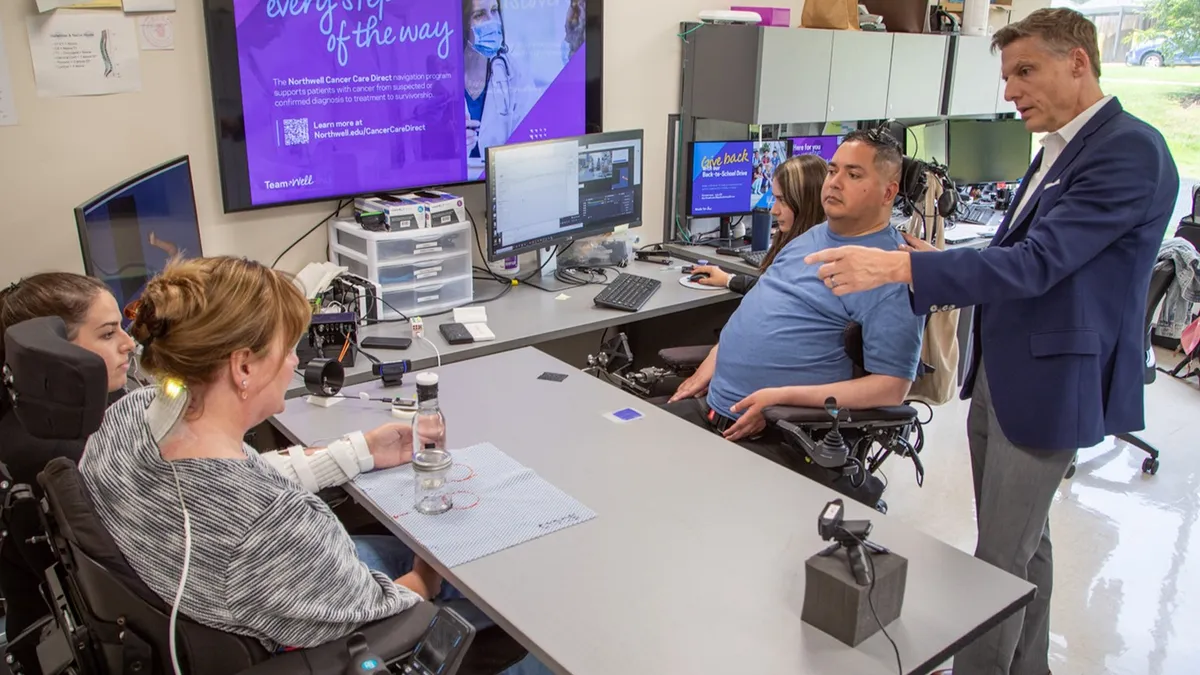By Futurist Thomas Frey
In 2040, medicine and robotics no longer focus solely on restoring independence—they’re reinventing the concept of embodiment itself. The line between “my body” and “your body” is starting to blur. The latest breakthrough came from the Feinstein Institutes for Medical Research, where a paralyzed man named Keith Thomas, who lost all sensation and movement after a spinal cord injury, regained not only touch and control of his own hands—but the ability to feel and move through someone else’s.
When Thomas dives into thought, his brain implant translates neural intention into electrical commands that travel wirelessly into electrodes placed on another person’s limbs. The result? He can move another person’s hands with the same precision as his own—and even feel what they touch.
In one remarkable trial, Thomas and a non-disabled woman both wore blindfolds as he guided her hands to grasp, lift, and identify objects. He could tell the difference between shapes and textures—through her skin, not his.
In another experiment, Thomas controlled the hands of a woman named Kathy Denapoli, who had partial paralysis from spinal cord damage. When Thomas used his implant to direct her movements, she lifted a water bottle, poured from it, and even drank from a can—all acts she hadn’t been able to perform alone in years. Both participants reported profound emotional experiences. Denapoli said, “I wouldn’t have done that without you.” Thomas replied, “I was more satisfied because I was helping somebody in real life, not just a computer.”
This is more than assistive technology—it’s the beginning of shared agency. The human nervous system, once bound by the skin, is becoming a networked system where multiple minds can inhabit multiple bodies. Neuroscientists call it “cooperative motor control,” but its implications stretch far beyond medicine.
Imagine the possibilities. A neurosurgeon in Boston could guide the hands of a doctor in Nairobi in real time—every delicate movement transmitted through a shared neural link. A pianist could lend their motor expertise to a student, not by instruction but through direct neural collaboration. A construction worker with years of experience could control an exoskeleton worn by an apprentice, teaching by doing—literally.
The moral terrain is as complex as the science. If a person can control another’s body, who holds responsibility for the action? In a world of shared nervous systems, does intent belong to the sender or the receiver? Future legal systems will need entirely new definitions of autonomy and consent. Philosophers will ask whether identity itself is still singular, or if humanity is evolving toward distributed consciousness.
What began as a medical miracle for paralysis may eventually redefine human collaboration. The “neural web” could become the next great platform—one where experience, skill, and sensation are transferable. We might one day license motor memory the way we license software. The idea of “lending a hand” could take on its most literal meaning ever imagined.
Final Thoughts
Keith Thomas’s story signals the dawn of what may become the “shared body economy,” where neural links make it possible to borrow another’s capabilities or restore one’s own. As implants become smaller, safer, and more adaptive, millions could regain not just movement, but purpose—by becoming part of a cooperative human network. The boundaries between people are dissolving, replaced by a strange and beautiful possibility: that we may come to inhabit each other’s lives, one thought—and one movement—at a time.
Read the original article on IFLScience
Similar stories:
Scientists Restore Touch to Paralyzed Limbs Using Brain-Machine Interfaces
The Rise of Neural Sharing: When One Mind Extends Into Many


